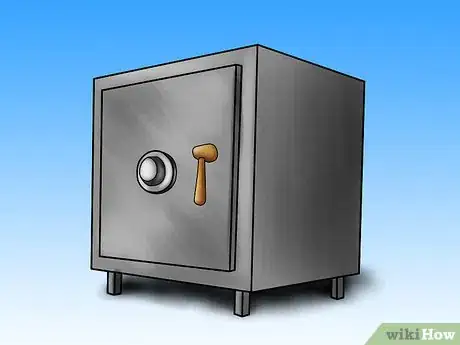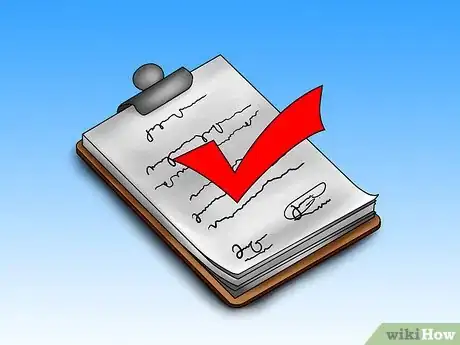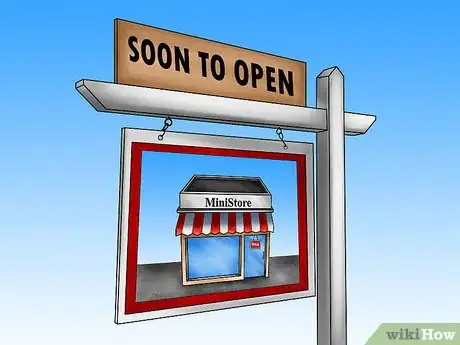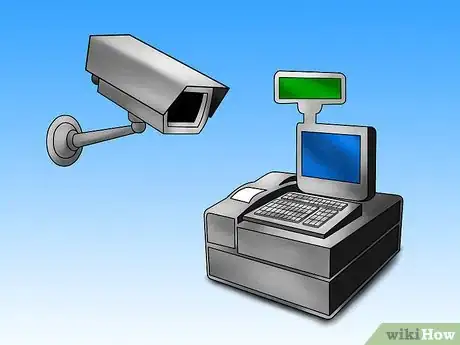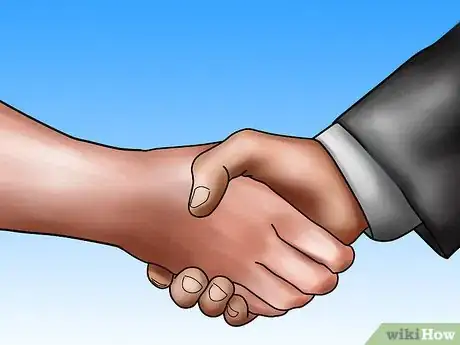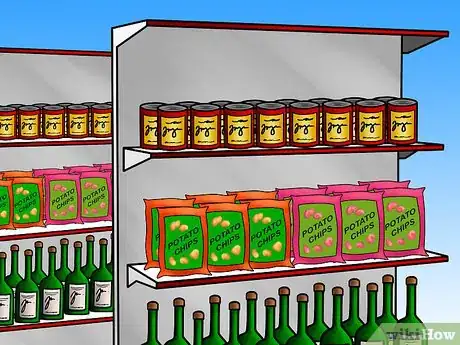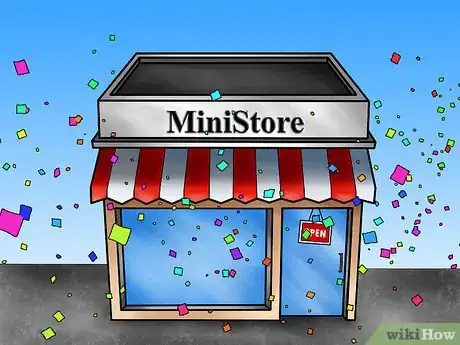This article was co-authored by Madison Boehm. Madison Boehm is a Business Advisor and the Co-Founder of Jaxson Maximus, a men’s salon and custom clothiers based in southern Florida. She specializes in business development, operations, and finance. Additionally, she has experience in the salon, clothing, and retail sectors. Madison holds a BBA in Entrepreneurship and Marketing from The University of Houston.
wikiHow marks an article as reader-approved once it receives enough positive feedback. This article received 19 testimonials and 100% of readers who voted found it helpful, earning it our reader-approved status.
This article has been viewed 521,112 times.
Starting a convenience store, just like starting any other business, takes money, planning, and time. Convenience stores are in demand all over the world, making them a good business to get into. With the right location, items in stock, and pricing structure, you can start turning a profit quickly after opening your convenience store. Read on to learn how to start a convenience store of your own.
Steps
Planning Your Store
-
1Decide whether you want to start your store from the ground up or buy into a franchise. A lot of money will be required in either case, but franchising may be easier in terms of marketing, advertising, and other setup tasks. You will likely have to pay a franchising fee out of your profit, but this may be considerably easier than doing everything on your own.[1]
-
2Develop your business and marketing plans, regardless of whether you are opening your own convenience store or a franchise. Though it may be slightly different for a franchise in that you don't need your own marketing ideas and you have business practices outlined for you, these documents will typically help you secure funding if you need to take out a loan. If you don't have them at all, you may run into difficulty securing the required capital.
- Create a business plan by listing the name and business structure (sole proprietorship, limited partnership, etc.) of your store. You can then continue by listing the items and services you plan to offer and the estimated startup costs for those items and services. For more information, see how to write a business plan and how to write a business plan for a small business.
- Develop your marketing plan by first analyzing your local competition and customer base. You can use sources like the US Bureau of Labor Statistics and U.S. Census for this information or contact your local branch of the US Small Business Association for assistance. Continue your marketing plan by analyzing the overall convenience store industry and then providing a plan for advertising, signage, and retention of customers. For more information, see how to create a marketing plan.
- Plan out details of when your business will be open and where it will be (if known).
Advertisement -
3Determine a budget for startup costs. This will largely depend on the cost of real estate in your area and what service and items you plan to offer. The startup costs for a convenience store can range from as low as $10,000 to well over $1 Million, so do your research and consider the costs of business in your area to determine your own budget. [2] [3]
- If you are starting a business, you should know the costs.
- You should understand a variable cost and a fixed cost.
- Fixed costs do not change every month. For example, the rent, utilities, and payroll. Variable costs change monthly, such as marketing expenses.
-
4Secure the required funding. Chances are, you won't have enough funding just lying around to cover your startup costs. This means that you will have to take out a loan to start your business. The Small Business Administration offers a variety of loan solutions to help new owners get their business started.[4] You can also check with your local bank for other loan options.
-
5Obtain the necessary licensing, permits, and insurance required to run your business. Make sure you are in compliance with all local, state, and federal guidelines. The insurance will protect you from theft as well as help provide worker's compensation if an employee is hurt on the job.
- At the very least, you will need a sales and use license from the state department of taxation in order to collect sales tax on items sold. If you sell any other regulated products at your store, like alcohol, cigarettes, lottery tickets, or gasoline, you will need additional licenses, as required by law in your state.
- Requirements for permits and insurance also vary by state. Check with the Small Business Administration in your state for more information.
Getting Your Business Started
-
1Secure your location. Location is everything in convenience stores. As the name implies, they should be convenient to get to. Stores off the beaten path may have a stronger local customer base because people don't want to go all the way to the grocery store, while stores near the highway typically get traffic from travelers who are not as familiar with the area.
- Ideally, a convenience store is highly visible and must have either convenient parking options or a large amount of outside foot traffic like in a transportation terminal, mall, or office complex.[5]
- To find the best locations for convenience stores, large corporations use Geographic Information Systems (GIS) reports to map local competition and demographics. These reports are generally too expensive for small business owners.[6] However, you can get the same information for free from the small business development center (SBDC). Go to their website, http://www.sbdcnet.org, and search for "convenience store tips" for more information.
-
2Purchase any necessary equipment for your store. You will need a security system with cameras and alarms, a cash register, coolers for drinks, shelves, and a credit card processing machine. If you are using an established store, you may not have to purchase all of this equipment. If you are providing any specialized services or products like lottery tickets or printing services, you will also need to purchase the necessary equipment.
-
3Get your location inspected. Before you start doing business, you will need to have your storefront inspected by the state department of health and the local fire department. This is required before you can legally begin to operate your business. Contact the required agencies for more information and to schedule an inspection.
-
4Establish relationships with suppliers. You'll need wholesalers to supply you with the goods you will sell, which include food and drink items, cigarettes, alcohol, paper and household goods, and fuel. You'll have to decide whether or not to use a full-service wholesaler, which may require larger order sizes, or several limited-function wholesalers, which may be more expensive and means additional for you. Both have their pros and cons, so consider the needs of your business before deciding.
- Another option, especially if you run a small store, is to get your supplies from a price club store, like Costco or Sam's Club. You will be responsible for picking up and shipping the items yourself, but you may save money this way.[7]
-
5Stock the store accordingly. Lay out your store shelves, and stock them with items. Use a method that will make ordering and restocking easy. Place your higher-priced or easy-to-steal merchandise within view of the clerk and a security camera.
- Consider who your primary customers will be and adjust your offerings accordingly. For example, if you are in a residential area, it would be beneficial to stock necessities like milk and bread so that locals will not need to go all the way to the grocery store. Alternately, a store surrounded by business will likely need to focus more on providing good coffee and breakfast.[8]
-
6Hire employees. You need trustworthy employees in this business as you could stand to lose both money and merchandise. Be thorough in your interview, check references, and consider background checks and drug testing.
-
7Open the store for business! Consider doing a grand opening with banners and special deals to attract customers. For example, you could offer free coffee to the first 100 customers. The most important thing is to get the word out and get customers in the door.
Community Q&A
-
QuestionHow much cash is needed to open a store from the ground up with 3,000 square feet?
 Community AnswerThat depends on many factors, starting with whose 3,000 square feet of property you're purchasing and where it's located. They could be nice and let you off cheap or if they know you're desperate they can raise the price. Then the size and type of building will affect the cost to build, and if you need to purchase a lot of equipment that will also raise the start-up costs.
Community AnswerThat depends on many factors, starting with whose 3,000 square feet of property you're purchasing and where it's located. They could be nice and let you off cheap or if they know you're desperate they can raise the price. Then the size and type of building will affect the cost to build, and if you need to purchase a lot of equipment that will also raise the start-up costs. -
QuestionHow do I run a convenience store alone?
 Community AnswerKeep a log book to keep track of supplies, purchases, income, debts etc. Make sure you're not vulnerable to theft, and be alert about everyone in the store. Be nice and courteous to customers since you're the only worker there and the representation of the service. When you have difficulty doing something, don't be afraid to ask help from someone or hire someone.
Community AnswerKeep a log book to keep track of supplies, purchases, income, debts etc. Make sure you're not vulnerable to theft, and be alert about everyone in the store. Be nice and courteous to customers since you're the only worker there and the representation of the service. When you have difficulty doing something, don't be afraid to ask help from someone or hire someone. -
QuestionCan I do this as a kid?
 DoggoTop AnswererIt's possible, but starting is business is very expensive and complicated -- your parents/legal guardian will have to do most of it.
DoggoTop AnswererIt's possible, but starting is business is very expensive and complicated -- your parents/legal guardian will have to do most of it.
Warnings
- Just like you might see in films or TV shows, convenience stores are prone to armed robbery. Think what you would do in the case of a hold-up.⧼thumbs_response⧽
- The main goal should be survival for the first six months at least. Many new businesses fail within the first year, and you would be competing against heavy competition from large supermarkets and retailers which often have the same items at lower prices. Also, online shopping and other convenience stores pose a threat to you as well. If you are serious about maximising profit, you might consider buying more than one convenience store to kickstart your empire. However, this will cost more upfront to start off. How will you finance it? Bank loan? Borrow money from family? Think.⧼thumbs_response⧽
- It really is a nickel and dime business. Remember, the smaller the store you have, the higher your per-item wholesale costs. Don't expect to earn a lot of money immediately.⧼thumbs_response⧽
References
- ↑ http://www.startupbizhub.com/Starting-a-Convenience-Store-Business.htm
- ↑ http://www.entrepreneur.com/businessideas/convenience-stores
- ↑ http://www.entrepreneur.com/franchises/categories/ffrtconv.html
- ↑ https://www.sba.gov/loanprograms
- ↑ http://www.entrepreneur.com/businessideas/convenience-stores
- ↑ http://www.sbdcnet.org/how-to-start/convenience-store
- ↑ http://yourbusiness.azcentral.com/much-cost-stock-convenience-store-29518.html
- ↑ http://yourbusiness.azcentral.com/much-cost-stock-convenience-store-29518.html
About This Article
To start a convenience store, consider buying into a franchise that already exists so you have access to their marketing, advertising, and other logistical support. Or, you can try starting your own convenience store from the ground up. Whichever route you take, you'll need to secure funding for your startup costs, which can range from tens of thousands to a million dollars. If you need help funding your convenience store, apply for a small business loan or try to find an investor. Also, you'll need to obtain the necessary licensing, permits, and insurance before you can open your business. To learn how to set up and staff a convenience store, scroll down!



